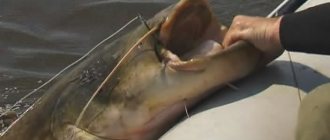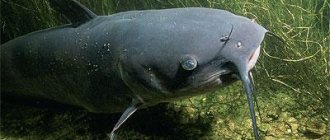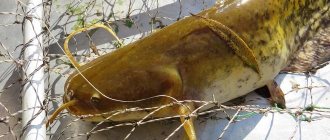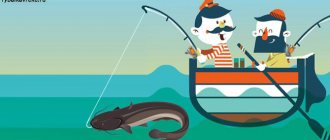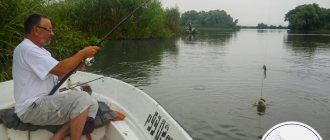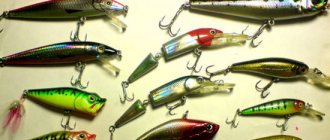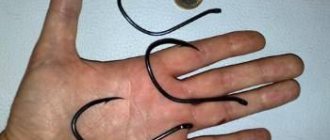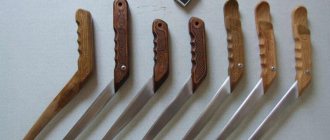Catfish
Having cut off the feeder leashes on several catfish, I wanted to combine bream and catfish fishing, setting out three tackles for catfish and two for bream.
As a result, I became convinced that purposefully hunting for two different fish was not at all annoying. Fortunately, their feeding places often coincide. And in terms of time, the bite of catfish and bream practically does not overlap - the catfish theme is more nocturnal, bream mainly takes during daylight hours, and there is no need to be torn between the two fish, although there are adherents of night catfishing.
Of course, bream is a more rewarding fish to bite, and the season for successful fishing is an order of magnitude longer. But the few catfish bites expanded the interest of my bottom fishing in the summer, but in September the catfish disappear somewhere, and I have to catch only bream.
At first, not everything went smoothly with catfish bait, and I was tired of experimenting - even, it seems, the super-reliable loach was only scratched by the catfish. Everything went smoothly when I began to bait the spike , which I got locally in the coastal submerged grass. True, other predators adore this small fish, including the medium-sized pike, which can bite off the leash; nevertheless, I caught most of my catfish using a spike.
My catfish tackle is quite reliable : a powerful rod and reel, a sliding weight of about 200 g, a strong hook, a main line of 0.5 mm, a leash of 0.4 mm, only braid serves as them. And with individuals up to 20 kg, there were no special problems when fishing.
There are also large breams. This year, in July, I raised a specimen weighing 5 kg. I took it carefully and almost did not resist until the landing net, pulled the fish like a bunch of algae, and thought that it was much smaller. But he turned out to be a giant! By the way, as good as the spike is for catfish, the larva of the cockchafer is excellent for large lesh; most of the large specimens were caught on the seal, which I usually support on the hook with maggots to hold on tighter. The most effective option for baiting bream is : first 5 maggots, then an omentum, and again 2-3 maggots. After each fish caught, the bait has to be changed - this seal is too delicate. I’ve heard more than once that catfish also favor this bait, but I’ve never caught one on the seal, although it’s worth experimenting with this matter more widely.
Methods of catching a beetle
What parts does the structure consist of?
The main distinguishing element is the underwater float. In this case, it does not display the bite, as is customary, but provides the necessary mobility of live bait or live bait in the current.
Thus, it becomes much more interesting for the chosen object of fishing - catfish. Comes in the form:
- cylinder;
- elongated ellipse.
The latter is considered universal because it is excellent for fishing both on the river and on the pond.
The raw materials used are cork, foam, polymers and other types that are characterized by good buoyancy.
The availability of materials allows you to easily make such a float with your own hands at home.
The photo clearly shows the main parts of the bottom equipment with an underwater float.
The weight is mounted using a sliding or blind method. Often, fishermen replace the standard sinker with heavy stones (weighing up to 2 kg), which guarantees self-hooking. But this option is only appropriate if the fisherman has a boat. The stone is wrapped with a thin cord and attached to the main tackle with a thin fishing line. When bitten, it breaks and does not interfere with fishing for the trophy.
As for fishing line, it is recommended to take braided line with a diameter of 0.32 mm or monofilament with a diameter of 0.5 mm.
The length of the leash can vary from 1.5 to 2.5 m. Swivels and fasteners are selected as strong as possible.
On top of the stone there is a leash through which a float is threaded. At the end there is a tee (hook) for attaching live bait or live bait.
The large length of the leash allows the baitfish to behave naturally in the water, which will not arouse suspicion among the attacking predator.
Catching catfish with a fishing rod
Wandering along the banks of rivers with a float bait fishing rod in search of the main trophy - pike, I am not surprised, but only happy at the periodic catfish bites. Moreover, the baleen climb higher and higher along small tributary rivers, having the opportunity to remain in large maternal reservoirs. Probably, these predators are eager to travel, or explore new territories, if there is such an opportunity. And normal specimens fall for the bait. I also had a catfish weighing 16 kg, caught on a small river 10 km from the confluence with the mother river.
As usual, I was about to catch a pike. A small carp on the tee, and off you go. Cloudy, there was a little rain in the morning. Settled down at a bend in the river. The opposite bank is overgrown with reeds, my burdocks are rising, there is no hole - about two meters of even depth. I let the bait fish in closer to the bottom, about 1.4 m from the float to the hook. The current is slow, and I caught it in the wire, periodically slowing down the float. The bite happened while braking. And not a pike, this “lady” usually leads sideways, but here the float instantly went under the water. After hooking, I felt a dull heaviness, as if I was caught in dense grass. But then there was movement. The thought flashed that there was a huge pike there. But he doesn’t want to float up. For about 30 minutes the fish rushed around the bend - now to that shore, then to mine, then in the center, and still did not show up. But then she surfaced, and her partner helped her get to shore.
The pike didn't bite at all that day. Maybe the catfish forced all the toothy ones to hide in their dens. In any case, I found a 400 gram pike in the catfish’s stomach.
Float tackle (fishing rod) for catfish or where it all started
Some time ago I became interested in bottom fishing and at first, due to lack of experience, I experimented with different equipment, baits and baits. But for the most part, I just wanted to find my own secluded catching place on the river, where I could mentally rest for an hour or two from the bustle of the city. Working days were so exhausting that waiting for a day off was something like a soldier counting down the days until demobilization.
The solution to the problem is obvious: you need to go after work. However, there was only about two or three hours left for evening fishing, and this is like showing a child candy, twirling it near his nose and putting it on the closet until the weekend. Repeatedly from familiar fishermen and in the fishing literature, stories about night fishing popped up: either bream for five kilos, then carp for twenty, then catfish for a hundredweight... These were either articles by professional fishermen, or “tales about sweatshirts” by locals.
But still, I understood one thing for sure: the fish bite at night!
Unfortunately, at first, it seemed to me that everyone was biting except me. Such furious injustice hurt my fishing pride so much that I came to one of the fishing trips “fully armed” and determined to catch “at least something.” In my arsenal there were spinning donks, stationary donks on reels, fishing rods and even a “rubber” (a donk with a rubber shock absorber), and from the names of baits it was possible to compile a small fishing dictionary. But... again, not everything happens as you think, and upon arrival at the river I saw a gloomy picture of a chain of fishermen, which stretched as far as the local vegetation allowed us to see the shore.
I found myself a barely noticeable piece of free space among the thickets of coastal bushes, on which it was inconvenient not only to fish, but even to turn around. There were neighbors' donks on the sides and from my island you could fish no further than 10-15 meters, otherwise you would definitely end up on the neighboring equipment. For gear, I decided to use two spinning rods and a short float rod. When it got dark, it turned out that casting a fishing rod in the dark, even with a flashlight, was extremely inconvenient because of the bushes in the way, and after several unsuccessful attempts, I simply lowered the rig into the water without casting, at the level of the fishing rod tip (about 4 m). I used several worms with bait.
After a certain time, the float floated clearly into the thick of the bushes hanging from the shore into the water. After hooking and playing for a short time, a catfish weighing 2.5-3 kg ended up in the cage. But what a catfish it was! The first night fish on my native river, and a huge one too! A real trophy catfish! At least I thought so for another couple of hours, until a slightly larger catfish coveted a simply huge bunch of earthworms.
According to my estimates, it contained over 10 kg. But... it was not possible to weigh it. There was a 0.25 mm fishing line on the fishing rod, which unfortunately could not hold up. From that night, my research began on the coastal zone of the river (within casting a fishing rod) for the purpose of catching catfish with a fishing rod. Naturally, after failure with my first qualifying catfish, I assembled another tackle, much stronger than the initial one and it consisted of:
- Bolognese rod;
- spinning reel;
- float with a replaceable thick antenna (for installing a firefly);
- cargo-olives;
- powerful swivel;
- leashes with different hooks.
My decision to use a Bolognese rod was influenced by the strength of the fish, which tore the 0.25 mm line like a hair. I thought next time I would loosen the friction brake a little and release the line as needed. The box with the braid indicated a decent breaking load (I don’t remember what it was) and it suited me quite well. Further, the very next nights, various experiments began with baits and fishing spots. Accordingly, we will move on to the next chapter of the story, which I called this:
Catching catfish with a jig
I periodically come across river catfish while fishing for pike perch - both predators often stick to similar sections of the river. But, unlike the fanged catfish, the catfish most willingly tries to hide in various bottom irregularities - sharp drops of entrances and exits from holes, steep side channel edges, hide behind a high sandy wave of a riffle, behind a sharp drop of a spit, lie down in some kind of mini-hole .
It is very difficult to clearly penetrate sharp changes with a jig, especially when fishing from the shore. I was dragging a jig head that seemed to have the right weight, but on the dumps I pulled it over the catfish. But he is not a pike to jump out high for prey. A jig head with increased weight helps out. Let’s say, according to the fishing conditions, it seems like you need to set 25-30 g, but I’ll set it to 40 or even all 50 g, and with the active step I break through the sharp drops that interest me as clearly as possible. With such a strong overload, it was possible to get some good catfish, especially a handsome one with a length of 1.55 m.
At the same time, the moment of selecting jig heads is full of various contradictions. I clearly break through the bottom with an overload, but the retrieve is hard, the pause is short, and the predator often prefers something completely different - during the pause the bait goes to the bottom for a long time, as if floating in the water column, and at the same time maintains contact with the bottom during pauses , during which the catfish attacks most often.
Such a leisurely jig, in most cases, is only possible from a boat, when casting downstream. And in this case, I select a jig weight that is less than for regular pike perch fishing - as long as after a pause of 5-7 seconds the bait still hits the bottom.
In addition to fishing the pit edges, I will also check the pit itself, and here, along a relatively flat bottom and maximum depth of the area, I lead the bait not with a step, but with a uniform, slow reeling, trying so that the head does not plow the bottom, does not go too high, but as if spread above the bottom, occasionally touching it - again selecting a certain weight of the jig.
I use fairly large rippers, 10-12 cm. In muddy water they are white, bright yellow, bright green. The cleared water, which usually occurs in August-September, revealed silver and golden rubber with sparkles.
Catching Catfish in Spring | There is an Important Point
Fishing for Catfish in early spring, when the water in some places begins to warm up and approaches 8°C, the mustachioed predator begins to wake up from hibernation.
Despite the fact that Som is still quite sluggish, there is still a chance of catching him. At this time, Catfish should be searched for in warmer areas of the reservoir:
The Shallows;
Mouths of Little Rivers;
Bays.
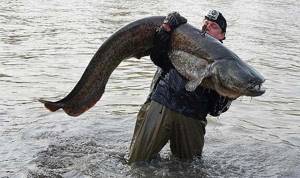
It is worth considering another very Important Point: There must be a Pit nearby, from where the catfish will go out to hunt. If there is not one, then you are unlikely to find catfish in this place, even if it is simply ideal for catfish.
I would also like to note that the warmer the water gets, the more active the catfish becomes.
3 ways to improve your fish bite!
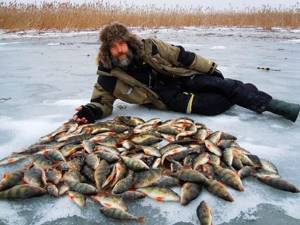
Over 15 years of active fishing, I have found many ways to improve the bite, and here are the most effective:
1. Bite activator . This pheromone additive attracts fish most strongly in cold and warm water. The Fish Hungry bite activator has proven itself to be excellent - Read more…
2. Tackle with increased sensitivity . You should first familiarize yourself with the features of using a particular type.
3. Pheromone baits . They attract the attention of fish, stimulate hunger and cause a schooling reflex, which allows you to collect a lot of fish in one place.
You can get the rest of the secrets of successful fishing for free by reading my other materials on the site.
3 ways to improve your fish bite!
Over 15 years of active fishing, I have found many ways to improve the bite, and here are the most effective:
1. Bite activator . This pheromone additive attracts fish most strongly in cold and warm water. The Fish Hungry bite activator has proven itself to be excellent - Read more…
2. Tackle with increased sensitivity . You should first familiarize yourself with the features of using a particular type.
3. Pheromone baits . They attract the attention of fish, stimulate hunger and cause a schooling reflex, which allows you to collect a lot of fish in one place.
You can get the rest of the secrets of successful fishing for free by reading my other materials on the site.
In my opinion, the best time for Catfish Fishing in the Spring is after lunch. In the spring, the catfish is quite weak, and it simply does not have the strength to chase fish and crayfish.
The best baits during this period are:
A bunch of crawlies;
Chicken offal;
Pieces of liver.
When the water temperature begins to approach the mark of 16 - 18°C, during this period the Spring Zhor begins at Catfish.
At this Time, he is not too picky about Bait, he eats everything he comes across, any bait (Catfish Bait) that you offer him. At this time, catfish can be found both in the Depth and in the Shallows, mainly these are Depth Changes, sharp Descents and Ascents.
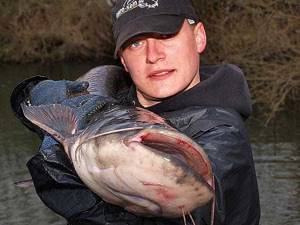
It is precisely at this time that Catfish fishing is most successful with artificial bait, which is what experienced fishermen do. Even on an ordinary Donka (Feeder) catfish are often caught at this time, of course small in size, but still they are caught and this is a Fact.
Since at this time the water level often rises, it is very advisable to look for catfish near flooded glades and lawns, since all living creatures are washed away from the fields and banks: Worms, Field mice, and so on.
I repeat once again that the best attachment at this time is a bunch of 20-30 crawls.
Fishing for Catfish in Early Spring in Difficult Conditions | Video
Catfish on kwok and silence
The quok must sound loud and clear, but the fisherman must sit in the boat as quietly as a mouse. In my opinion, this is the fundamental rule of quok fishing. If only catfish up to 6-7 kg are caught, then usually the reason is banal - a large fish is simply afraid to approach a “noisy” boat. There are probably no other ways of fishing where silence in the boat plays such an important role. It seemed that the fish certainly could not be alarmed by the fisherman's conversation in a low voice. But it feels alarming, and for some time now, when fishing with a friend, he switches to communicating with gestures, maintaining complete silence. Surprisingly, this point remains important even when motor boats are rushing nearby in the catfish pit.
I also largely associate the choice of a particular boat with the catfish’s suspiciousness. The ideal of “camouflage” is seen to be a small decoy, but it is of little use for hunting large predators. There was a case when the quacker slightly tore the catfish away from the bottom soil, but it then pressed so hard that it could not be held, the cord pushed through the bow of the boat, and water poured into the hole. I had to urgently cut the cord, losing fish and tackle. A boat with a rigid hull is the most reliable, the same unforgettable “Kazanka”, but if something falls to the bottom, then there will be no bite. Even if a strong wave hits the side of such a boat, a large catfish will not fit. But the hook “in iron” can be used freely, without fear of breaking through the side or bottom. More often I fish with a medium-sized inflatable, the main advantage of which is noiselessness and compactness.
There is no point in talking about the equipment; it is banally simple and well-known. I will only note that instead of a traditional lead sinker I use a brass one. Probably for the same reason that brass vibrators are considered more catchy compared to iron ones... The weight of the load is about 130-140 g. There are also 200 g in reserve - for periods of high water with strong currents, but such conditions occur every year less and less.
Personal quok
Watching the old professional comrades who had lived their whole lives on the river, I noticed that the quokkas were all different in shape. Only the shape of the heel hitting the water is similar. It turned out that each fisherman makes his own quok for catfish, hence the different forms. One hits harder, the other weaker. One works with a pull - hitting the water with a sharp pull of 30 centimeters. The other hits with a "gurgle" - a sharp hit on the water from a height of 10-15 cm, the heel grabs the air and accelerates deeper. And what’s interesting is that there are many ways to strike, but they all produce a very similar sound. And if someone takes someone else’s knock, then you can’t immediately hit beautifully, you have to adapt for some time, and there’s nothing good about it - you need to change your habits when you hit automatically, without thinking, but then you need to be smart about something , raping his hand.
I came to the conclusion that in the quok everything is the same as with your favorite spinning rod, with which we send the bait exactly to the intended place, but if you take someone else’s, you still need to shoot.
Kwok on catfish varieties
Catching catfish on a donk
I don’t agree that, for the most part, small catfish are caught using donka. My partner and I regularly catch fish weighing 10-20 kg, and there have been some over 40 kg.
Yes, small catfish are often caught on a donkey, but not because it is a donka, it’s just that it is often installed where schools of juvenile catfish like to stay, and naturally, small mustachios will actively grab the various animal baits offered to them. But any catfish tackle is just one of the tools for a fisherman who knows the habits of the mustachioed giant, who can imagine where and when he can catch not the ubiquitous catfish, but a really large predator. We usually set out from the steep at the transition from depth to shallows - it is along the edges that large catfish most often move, and small fish usually move haphazardly. It makes sense to check small places bordering the pits. Good points can be adjacent to the very edge of the water, and located at a considerable distance.
If the installation location is chosen well, then large catfish can be caught using fairly compact baits, such as loaches, and small catfish are rarely found here. True, it can be difficult to get loach in recent years, but it is a good replacement for an ordinary 5-6 cm crucian carp, we hook it to the back. The best bite for catfish on donka is observed in July-August, sometimes a good bite continues until mid-September. But, as a rule, the arrival of autumn is marked by a sharp weakening of the bottom bite of catfish, and then with a clear conscience you can switch to spinning pike fishing.
Methods of catching catfish. The most effective and widespread.
The hook should be large - from No. 30 and above (according to our classification).
How to catch a giant.
The zherlitsa is thrown directly into the pit where the giant lives and left overnight. In the morning the gear is checked. Very often the fish gets caught in snags. But in this case you shouldn’t pull too hard, it’s better to wait a little, usually the somyar swims out and then you need to fish it out.
Fishing “on the poke”
Another interesting way of catching catfish is “poke” fishing. A “poke” is a flexible pole that is driven into the bottom of a reservoir. A small slot 5-6 cm deep is made in its upper part. The tackle, like on a pole, is fixed on the shore and, passing through the slot of the pole, goes into the reservoir. The catfish swallows the bait, feels elastic resistance, tries to free itself and is hooked, but the pole, like a shock absorber, prevents the fish from swimming into the snags and entangling the tackle, and also tires the fish caught on the hook.
Another way to catch catfish “on a log”
The next passive type of fishing is fishing “on a log”. A small log is taken, a leash with a bait (usually live bait) of such length is tied to it that it floats just 20 cm above the bottom of the hole. Then the log is tied to a cord that is firmly fixed to the shore. It is also advisable to make fixing guy ropes from thin fishing line during the current, which will not allow our “float to float to the shore.” When a catfish bites, a self-hook occurs, and the fish, trying to get rid of the hook, will drag the log across the pond and get tired . The next day the fisherman pulls out the already exhausted fish.
Passive methods of catching catfish
All of the types of catfish fishing described above are passive , i.e. the fisherman just pulls out the self-hooked fish and that’s it. But there are also active types of fishing. Of these species, I would like to mention fishing with quok.
An active method of catching catfish using a kwok
Even in ancient times, it was noticed that catfish are attracted to the sounds of objects that, at the moment of impact, bring a certain amount of air under the water. The fish rises from the day and, interested in these sounds, rises higher and, having found the bait on the fisherman’s hook, grabs it.
Undoubtedly, the main component in this type of fishing is the kwok . It is a large curved knife with a handle and a “patch” at the tip of the blade. It is this snout that makes these sounds.
Buy or make it yourself?
In modern times, you can buy kwok in fishing stores, but many connoisseurs of this fishing prefer to make this device themselves.
Material for making “quoka”
as nickel , which must be dried. Ideally, you need to dry it in a dark room for quite a long time, but people have come up with their own modern way of drying. Take a nickel blank and place it in a microwave oven (it’s better to take several blanks at once) and heat the wood to a temperature when steam starts coming out of it. Take out the blanks, wrap them in newspaper and pack them tightly in a plastic bag until they cool. This procedure is repeated several times until moisture ceases to be released. After drying, they begin to grind out the “nickel” of the kwok. The nickel has a height of about 5-6 mm, length – 45 mm and width – 25 mm. Front and back parts, pointed towards the bottom.
Although some fishermen round the back of the penny at the bottom. A cut is made in the center of the workpiece under the tip of the knife. The prepared part is sanded, impregnated with drying oil and varnished. Wooden penny is considered the best and surpasses all other materials in sonority and purity of tone.
Kwoka base
titanium plate with a cross-section of 2 mm, a length of 25 cm and a width of 3.5 cm is used as a knife - at the widest part at the handle and 2 cm at the penny. It is very difficult to process, but has a number of advantages over other “competitors”. In particular, titanium is very light and durable (does not bend when “creaking”). Only a knife made of wood can compare with it, but it is thicker and the resistance of the water also puts a lot of strain on the angler’s hand. The edges of the knife are sharpened on both sides.
handle is made of wood with a diameter of 25-30 cm and a length of 140-150 mm. At the very beginning, a cut is made under the base of the knife.
Assembling the quok
After preparing and adjusting the parts, they begin to assemble using waterproof two-part epoxy resin. For better and more reliable fastening in wooden parts, holes are made in the knife at both ends. When assembling, you need to remember the following points:
1. The handle of the knife and the lower plane of the coin are strictly perpendicular to each other.
2. The alignment of the handle and the coin is disrupted by the blade of the knife. The misalignment for the carpal quok ranges from 3 to 7 cm.
After assembling and drying the kwok, try it on water and listen to the sound . Here, if you have never heard a quok, you can watch (listen) to videos on YouTube and other sites and compare them with yours.
When catching catfish with a quok, we need
In addition to the quok, you will need fairly thick cord a hook (large, especially for fishing with the quok). Many fishermen place two hooks at once: a smaller one of the tackle
This is explained by the fact that sometimes the catfish is cautious and grabs the protruding parts of the nozzle and does not swallow the whole thing. The main requirement for a hook (besides its size) is sharpness , because... breaking through the lips of a catfish when hooking is not so easy.
Will you need a fishing rod?
A fishing rod is not required when fishing with a quok. The end of the cord is tied to the boat or brush. The cord is lowered from the boat into the water and held with the left (if you are right-handed) hand, and the right hand works as a kwok . Excess cord is carefully wound up in the boat and can be pulled out when fishing.
And now about the nozzle.
Pearl barley mollusks and frogs are used as bait It has been noticed that the number of bites increases if the bait is fresh , and best of all, live .
Catfish bite
the touch of the nozzle to the bottom, snags, etc. also felt.
Kwok fishing technique
The fishing technique is as follows. The fisherman swims to the beginning of the hole and floats down it with the current. At this moment the bait should be slightly above the bottom (sometimes at half-water or higher). Next you need to make 3-4 strikes with a kwok, wait a short pause of a few seconds and again 3-4 strikes, etc.
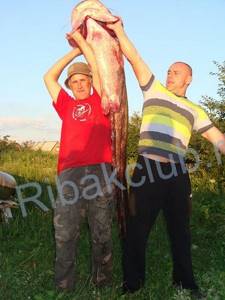
In the boat, while fishing, you need to maintain strict silence . Nothing should be heard except the sound of the quok.
Happy fishing!
The secret way to catch catfish
They say that there is no remedy against crowbar, and if a large catfish has gone into the snags, then the most unpleasant thing has already happened, the trophy is considered lost . We can agree with this, but there are often exceptions when you can continue to fight and emerge victorious.
As an example, I will give the story of catching a two-meter catfish weighing 56 kg. It happened on the Don this summer. At about 7 o'clock in the morning the boat passes along the edge of the fairway, at the exit from the hole the echo sounder shows 5 m - a powerful bite on a rainbow-colored Halko wobbler with a depth of 5 m. 0.36 mm) the catfish still managed to escape with a powerful jerk into the snagged section of the river; the force was such that it was simply impossible to restrain its impulse. I already mentally said goodbye to a good wobbler, since the hook seemed quite serious. But I decided to use a secret method that had helped me out more than once on previous fishing trips . I pull the cord tightly with my hand, hear the fish rubbing against the snag, and then abruptly release the cord. I did this several times, and with the next pull I didn’t hear the usual friction of the cord against the snags, I only felt a dull catch. I glanced at the shore and was stunned by the fact that I was already swimming along the river with the catfish - and the “hook” came to life!
Usually the catfish returns from the blockage the same way it entered it, and the further course of the fish can be predicted. This time nothing was calculated, and in general the fight dragged on. The catfish was wild - it rushed from side to side, then went against the current, then went to the opposite, more snaggy, steep bank, but I tried my best not to let the fish go there. Fortunately, a powerful spinning rod (test up to 120 g) and a well-adjusted reel clutch did not give the fish much free movement, gradually tiring it. We tested each other's strength for about an hour, and only on the third supply the mustachioed one was lifted to the surface of the water, successfully rigged and transported by tug to the opposite, flatter shore. This time the snags could not help the cunning fish.
An integrated approach to catfish fishing
Trolling and quok are two radically different ways of catching catfish, which cannot be called friendly. And I much prefer fishing with a quok, however, on the same day I often combine both methods, since I want to take advantage of every chance of biting a large catfish.
In the morning I usually go scouting with a wobbler. If there are no bites, then at about 10 o’clock I start crowing - in my practice, quaking for catfish at dawn does not work very reliably. When working with a quok, I pay especially close attention to the echo sounder information. It happens that there is no grip, but the device clearly notes that the predator rises at the sound of the quok, refusing to attack, and descends again. But this circumstance is already encouraging - the fish is at least moving somehow and will probably bite the wobbler, fortunately it is now clear where it is promising to troll.
If there were no fish rises, then there is no point in trying to catch fish; I was convinced of this many times; pike perch or pike can still be caught here, but not catfish.
The third scenario is the most joyful for me - the catfish is caught on the hook, then I don’t even think about trolling, especially since the large mustachioed one immediately exceeds the daily catch limit. It is important that there are entire seasons when one piece of gear works much better. I remember that trolling worked much better than quok in the summer. And in September that season, catfish took wobblers like crazy. The quok was much worse, only one large one was caught, and that one broke loose and left. But I also remember the full-water year, when in high water the mustachioed fish caught perfectly on a hook, but poorly on a wobbler, and many trollers complained about very disappointing results. That is why there is no single answer to the question: which method is more effective - a quok or a wobbler? Both gears complement each other perfectly.
Baits for catching catfish
Bunches of crawling worms, live bait, dead fish, chicken giblets, and frogs are used as bait for catfish; for large fish, slightly rotten bird carcasses singed on fire. Although the catfish more often attacks live prey, it will not refuse carrion, and in some cases even gravitates towards it.
I recommend to read:
Tench - description and catching
Hercules for fishing
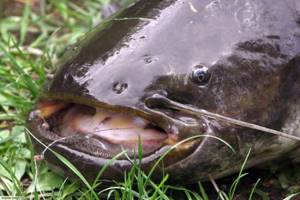
Share with your friends!
Catfish per circle
I spotted an interesting juxtaposition of catfish and large perch with my friends in the summer at the same reservoir. Initially, we went for the pike, having learned that it had hatched well the day before. We arrived, and in two days we didn’t catch a single pike with a circle, or with a spinning rod. Seeing that things were very bad, they began to place moored circles in small grassy windows, some of them were no more than a square meter in area, assuming that the toothy one had huddled in the grass.
Equipment for the circles : fishing line 0.5, a heavy weight at the end, a 30 cm leash with a tee attached 40 cm above. As a live bait - crucian carp about 5 cm long, hooked on the back in the classical way.
And there were bites, not pike, but catfish! Moreover, the fish were not small, and not a single one was picked up because of the thick grass - the predator broke the leash or got off the hook with impunity.
We didn’t see a single pike bite in the windows, but mixed with catfish there was an excellent perch in the region of 500-600 g, and there were also real humpbacks for 1 kg. In general, the perch helped our fishing. And he surprised me with his courage - he stayed in the same places with large catfish, not shying away from such a dangerous neighborhood.
As for catching catfish with live bait in such conditions, I can’t even imagine how strong the equipment must be in order to tire the fish in the dense wilds of aquatic vegetation and then successfully lift it into a boat with a huge bunch of grass! Here in open water spaces, a circle for catfish can be very catchy, and again, for the most part, in an anchored position, which allows you to catch not only on the lake, but also on the current.
The best places and times for catching large catfish
It is well known that in rivers with pronounced holes more than 8-10 meters deep, catfish should be found. Often such holes are easy to detect by whirlpools and strong currents. For beginners in this matter, a wireless echo sounder will be very helpful. With its help, it is easy to find holes, and therefore places where catfish are likely to stay.
It should be understood that catfish is a heat-loving fish. It is most active in the summer, as eloquently evidenced by the fishing calendar.

After spawning, which occurs during the period when the water has already warmed up to 20 degrees, the catfish begins to really eat. Large individuals often choose deep holes or holes that are in the shade, a little further from the main current. Catfish love to be found near flooded trees and large snags. Here they find food and reliable shelter. You should always remember that large catfish live an isolated life and do not gather in schools. Therefore, it is imperative to find holes at least in a local area. Promising places for catfish fishing will be areas located below dams and locks.
At the height of summer, catfish are more active in the evening and at night. Donors are well aware of this. It is for this reason that they come to the fishing spot in the evening for evening and night fishing.
Interestingly, in the evening it is better to cast to the beginning of the hole, or to its exit. Catfish are caught quite well in areas with a large difference in depth. Large specimens go out into shallow water at night in search of food. Sometimes you can catch such a specimen at a meter depth.
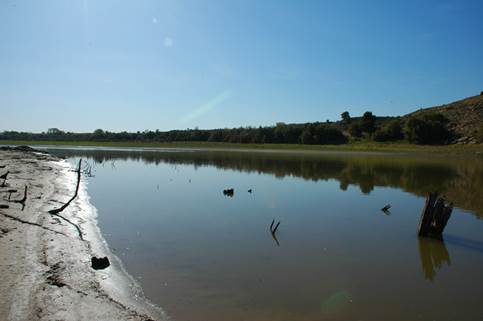
If the night is warm, then the catfish can indicate itself with loud chomping or splashing sounds. It is safe to assume that catfish hunt all living things on the surface of the water. In this case, it is very useful to place the nozzle not on the bottom, but slightly higher. Using equipment with an underwater float, you can easily place worms or other living creatures on the desired horizon.
It is important to remember that the catfish reacts very sensitively to the slightest fluctuations. Therefore, the nozzle should move. This should definitely be taken into account. If you fish with a stationary bait, the effectiveness of such fishing decreases noticeably.
When is the best time to catch trophy catfish? This question worries many fishermen. However, there is no clear answer to this. On some days, catfish take only at night, and sometimes at dawn. In terms of time, this most often happens from 7 to 11 pm and from 2 to 6 am. It happens that catfish are caught well from 12 to 4 at night. This happens most often on warm nights.
The activity of large catfish is also influenced by the transparency of the water in the river. In muddy areas with opaque water, it can be caught well throughout the daylight hours. On cloudy summer days, catfish are overly active. And before a thunderstorm, he completely forgets about everything and becomes even more active.

Before fishing, it is important to scan the area and identify the areas with the deepest holes. They will be needed in case there are no bites in the chosen place. Sometimes a small but deep enough hole of more than 10 meters will be life-saving. When fishing in such a place you can count on a good bycatch. If the catfish doesn’t take it, then at least roaches and bream will be caught.
If you manage to find a deep and wide hole, then the emphasis should be on the deepest point and on the exit and entrance to the hole. It’s good if there is a slight elevation in the hole. For a more detailed study of the relief in the pit, it is better to use an echo sounder. It is important to identify all the snags and other obstacles and understand where exactly to throw the equipment so that it does not get carried away by the current into the snags.
When catching large catfish, you should not keep the bait in one place for a long time. If there are no bites for more than 40 minutes, then it is better to drag the bait a little closer. By doing such stretches every 30 minutes, you can fish the entire perimeter of the hole and still find the point where the catfish will take it.
Catfish for jig
On some rivers, the ancient fishing of catfish using a vertical jig, or rather, a jig, is beginning to be revived - the weight of the bait reaches 150 g! This catfish jig is similar in size to a small pear, and its shape also resembles a well-known fruit. Of course, you can’t buy such baits in a fishing store; fishermen cast them themselves. Lighter jigs are also used, the weight of which depends on the strength of the current. A freely released bait should reach the very bottom without being deflected too much by the jets; the maximum deflection angle is 30 degrees. They fish both with and without a quok at proven points. The tail or a whole small fish with thick skin, often a loach, is placed on the jig hook.
It happens that the catfish is capricious, then they expand the arsenal of baits used - they try to catch large grasshoppers, crayfish, crawlers, leeches, and barley shell meat with a small frog, locusts or “faggots”. When there are no bites, there are bites on cabbage butterflies and cockchafer larvae. And some people think that the best bait for catfish is fillet from the backs of minnows. What most fishermen agree on is that at different times in specific sections of the river, the mustached one may prefer a certain type of bait. And if there are no bites, this does not mean that the catfish has not yet sniffed and rejected the one it doesn’t like.
The jig works more successfully in the morning and afternoon at the very bottom, and at sunset at mid-water. They can catch both from anchor and while drifting. In the first case, having anchored the boat, the fisherman hands over the halyard, moving with the current, consistently fishing the entire hole. In long pits, the supply of anchor halyards can reach hundreds of meters. An anchor makes fishing easier, but experienced fishermen say that when large catfish bite, there are times when you have to cut the halyard to get a large fish.
Effective baits for predatory fish during spring fishing
Catfish begin to actively hunt when, at the end of March - beginning of April, the water in the rivers warms up to +10C. The sooner the ice begins to drift and the water in the reservoirs warms up, the sooner you can go fishing for catfish.
But in early spring, the water warms up only at the surface of the river or in shallow waters. Therefore, this nocturnal predator changes its “day routine” and begins to feed on small organisms in shallow waters during the daytime, and at night does not react even to delicious baits.
In early spring, the water on the rivers warms up unevenly, warm areas of water are found only in shallow water, so the activity of these river predators also manifests itself from time to time. They may peck for several days and then go into hiding.
Spawning of catfish begins during the period when the water temperature rises to 17-19C. The spawning period lasts about 17-18 days, then the catfish lie down to rest. And only after some time they begin to actively eat, so they rush to animal bait.
Read: Fishing with dough
Catfish are most actively caught during this period on:
1. Vypolzkov. To catch catfish you have to use large hooks. 5-8 crawlers should be strung on them so that the bait completely hides the hook. This type of animal bait is usually used to catch catfish weighing no more than 2.5-3 kg.
2. Live bait and pieces of fish. The size of the fish caught directly depends on the size of the live bait. Interestingly, catfish are more actively caught using live bait that was caught in the catfish’s habitat. To catch small-sized catfish, fishermen string pipe cleaners, perches, and minnows on a hook. To catch large specimens, anglers take crucian carp or roach. Also, many fishing enthusiasts use pieces of large fish, or the head or tail, as bait. And predatory fish in some reservoirs prefer only fish heads, and in other places they prefer fish tails. Catfish also bite well on canned gobies in tomato, but such pieces of fish are too soft, so they are difficult to attach to hooks.
3. Frogs. This is what catfish eat most often in the spring; they do not disdain them in the summer or early autumn. Therefore, such bait can help anglers catch large specimens of predators.
4. Sparrows. These small birds are first roasted over a fire and then skewered on a hook. Catfish often bite on this type of bait, perhaps because the birds are a delicacy for river predators. Sparrows are caught for fishing using special traps. If you catch several birds, you can be sure that a couple of large catfish will definitely “bite” on such bait.
Read: Methods for putting a worm on a hook
5. Perlovitsa. Such bivalve mollusks are a favorite delicacy of catfish, and they are found in all Russian reservoirs. The meat of pearl barley is placed on the hooks, and you can be sure that the catfish will definitely fall for such bait.
6. Locust. Under natural conditions, it is extremely difficult to catch locusts, although this type of bait is considered the best delicacy for any predator fish. Usually, many fishermen go to the southern Russian regions for locusts, where they stock them in large quantities. Up to 5-6 locusts are placed on hooks. Catfish of different sizes effectively bite on this bait.
7. Chicken liver. Chicken giblets are another delicacy for river predators that grab such bait on the fly. Before placing the liver on the hook, you need to prepare it - leave it in the sun for a while. As a result, such bait will exude a peculiar aroma, which predatory fish will swim towards.



